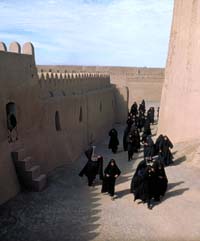What does Islam teach about ecology?
 |
 |
 |
Women go to prayers in a mosque built with sun-baked earth in the Sudan. |
Khalifa - trusteeship
Islam teaches that Allah created humans to be guardians of His creation. In other words, nature does not belong to us to do with as we wish, but is entrusted by Allah to our safe-keeping.
‘The world is green and beautiful, and Allah has appointed you his guardian over it,’ taught the prophet Muhammad.
Tawheed - unity
The central concept of Islam is tawheed, or unity. Allah is unity, and His unity is reflected in the unity of humanity and nature. We must therefore maintain the integrity of the Earth, its flora and fauna, its wildlife and environment. Our responsibility is to keep balance and harmony in Allah’s creation.
Akrah - accountability
Islam teaches that we will one day be judged by Allah for how we have discharged our responsibilities following the guidance of Islam. Have we been good trustees, and have we kept nature in harmony? So there will be a day of reckoning.
Avoid waste
It is said in the Qur’an that Allah invites us to enjoy the fruits of the earth, but to avoid excess leading to waste, ‘for Allah does not love wasters.’
Shariah
All these principals have been translated into practical directions for how to live, embodied in the Shariah, the laws of Islam. For example, Shariah law protects animals from cruelty, conserves forests, and limits the growth of cities.
Islamic conservation in practice
Here is an example of specialist leaflet written to explain the Islamic theology of conservation as well as practical ideas for Islamic communities to protect endangered pollinator species in urban areas.
|

